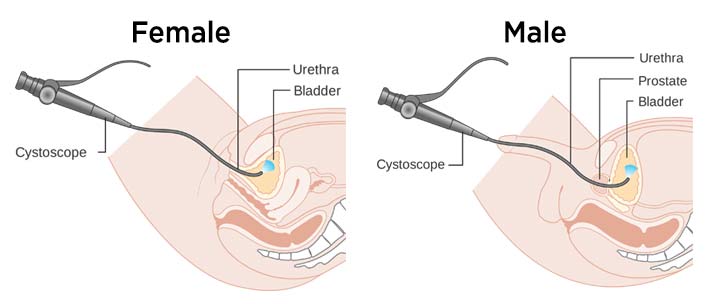Cystoscopy
What is a cystoscopy?
A cystoscopy is a medical procedure that allows your doctor to inspect the bladder and the urethra. Your doctor will slowly insert a small tube affixed with a light and a lens into your urethra. The cystoscope acts like a telescope, allowing your doctor to visually examine your bladder and urethra. During some cystoscopies, your doctor may affix a camera to the scope which can display the images onto a screen.
An anesthetic jelly may be used to numb your urethra, with sedation, or with anesthesia. The reason for your cystoscopy will help determine which method is most appropriate for you.
The procedure takes about 5-10 minutes to complete.

Reasons for Cystoscopy Procedure
A cystoscopy procedure helps your doctor diagnose, monitor, and treat conditions affecting your bladder and urethra. Your doctor may recommend this procedure to:
• Inspect stones that are too large to pass (larger than 5 millimeters)
• Help diagnose the underlying cause of gross hematuria (visible blood in urine), microscopic hematuria (blood in urine visible only with a microscope), incontinence, overactive bladder, and painful urination.
• Look for an underlying reason for recurrent urinary tract infections, though the procedure is often postponed if there is an active infection.
• Diagnose an enlarged prostate. A cystoscopy allows your doctor to see if an enlarged prostate (BPH) is causing the urethra to constrict, resulting in urinary problems. Your doctor may also perform a cystoscopy before other BPH treatments like Rezum or surgery like TURP to take measurements and inspect the area. This will help your doctor evaluate the likelihood of procedure success and measure the effectiveness of the treatment.
• Diagnose bladder conditions, including bladder stones, bladder cancer, and bladder inflammation.
• Treat bladder conditions. In some cases, your doctor may be able to remove small bladder tumors during a cystoscopy.
Potential Risks of Cystoscopy
• Infection
• Excessive bleeding
• Blood in urine (hematuria)
• Pain with urination
• Temporary inability to urinate, which may require additional treatment. (urinary retention)
Frequently Asked Questions
How do you pronounce cystoscopy?
(sis-TOS-kuh-pee) in a urology clinic, you may hear practitioners refer to the procedure as a “Cysto” (SIS-toe).
Quick Facts
Cystoscopy Doctors
All Urology San Antonio’s doctors use the cystoscopy procedure as needed for diagnosis.
